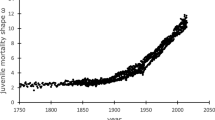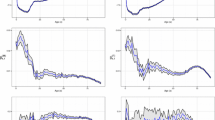Abstract
In this paper, a generalized GARCH-based stochastic mortality model is developed, which incorporates conditional heteroskedasticity and conditional non-normality. First, a detailed empirical analysis of the UK mortality rates from 1922 to 2009 is provided, where it was found that both the conditional heteroskedasticity and conditional non-normality are important empirical long-term structures of mortality. To describe conditional non-normality, a double-exponential distribution that allows conditional skewness and the heavy-tailed features found in the datasets was selected. For the practical implementation of the proposed model, a two-stage scheme was introduced to estimate the unknown parameters. First, the Quasi-Maximum Likelihood Estimation (QMLE) method was employed to estimate the GARCH structure. Next, the MLE was adopted to estimate the unknown parameters of the double-exponential distribution using residuals as input data. The model was then back-tested against the previous 10 years of mortality data to assess its forecasting ability, before Monte Carlo simulation was carried out to simulate and produce a table of forecast mortality rates from the optimal distribution.





Similar content being viewed by others
References
Bollerslev T (1986) Generalized autoregressive conditional heteroskedasticity. J Econ 31:307–327
Cairns A, Blake D, Dowd K (2006) A two-factor model for stochastic mortality with parameter uncertainty: theory and calibration. J Risk Insur 73(4):687–718
Cairns A, Blake D, Dowd K, Coughlan GD, Epstein D, Ong A, Balevich I (2007) A quantitative comparison of stochastic mortality models using data from England and Wales and the United States. http://ssrn.com/abstract=1340389. Accessed 24 Aug 2012
Chen H, Cox SH, Wang SS (2010) Is the home equity conversion mortgage in the United States sustainable? Evidence from pricing mortgage insurance premiums and non-recourse provisions using the conditional Esscher transform. Insur: Math Econ 46:371–384
Currie ID (2006) Smoothing and forecasting mortality rates with p-splines. http://www.ma.hw.ac.uk/iain/research/talks.html. Accessed 13 Aug 2012
Dickey DA, Fuller WA (1981) Likelihood ratio statistics for autoregressive time series with a unit root. Econometrica 49:1057–1072
Engle R (1982) Autoregressive conditional heteroskedasticity with estimates of the variance of UK inflation. Econometrica 50:987–1008
Gao Q, Hu C (2009) Dynamic mortality factor model with conditional heteroskedasticity. Insur Math Econ 40(3):410–423
Giacometti R, Bertocchi M, Rachev ST, Fabozzi FJ (2012) A comparison of the Lee–Carter model and ARGARCH model for forecasting mortality rates. Insur: Math Econ 50(1):85-93
Lee RD, Carter LR (1992) Modeling and forecasting US mortality. J Am Stat Assoc 87(419):659–671
Lee RD (2000) The Lee-Carter method for forecasting mortality, with various extensions and applications. N Am Actuar J 4:80–93
Mitchell D, Brockett P, Mendoza-Arriaga R, Muthuraman K (2013) Modeling and forecasting mortality rates. Insur: Math Econ 52(2):275–285
Renshaw AE, Haberman S (2012) Parametric mortality improvement rate modelling and projecting. Insur: Math Econ 50:309–333
Renshaw AE, Haberman S (2006) A cohort-based extension to the Lee–Carter model for mortality reduction factors. Insur: Math Econ 38:556–570
Siu TK, Tong H, Yang H (2004) On pricing derivatives under GARCH models: a dynamic Gerber–Shiu approach. N Am Actuar J 8(3):17–31
Taylor SJ (1986) Modelling financial time series. Wiley, New York
Willets R (1999) Mortality in the next millennium. In: Paper presented to the Staple Inn Actuarial Society, London, England
Willets R (2004) The cohort effect: insights and explanations. Br Actuar J 10(4):833-877
Author information
Authors and Affiliations
Corresponding author
Appendix: Forecasts of mortality rates
Rights and permissions
About this article
Cite this article
Chai, C.M.H., Siu, T.K. & Zhou, X. A double-exponential GARCH model for stochastic mortality. Eur. Actuar. J. 3, 385–406 (2013). https://doi.org/10.1007/s13385-013-0077-5
Received:
Revised:
Accepted:
Published:
Issue Date:
DOI: https://doi.org/10.1007/s13385-013-0077-5




